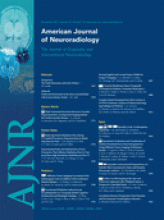Research ArticleBrain
Open Access
Brain Iron Quantification in Mild Traumatic Brain Injury: A Magnetic Field Correlation Study
E. Raz, J.H. Jensen, Y. Ge, J.S. Babb, L. Miles, J. Reaume, R.I. Grossman and M. Inglese
American Journal of Neuroradiology November 2011, 32 (10) 1851-1856; DOI: https://doi.org/10.3174/ajnr.A2637
E. Raz
J.H. Jensen
Y. Ge
J.S. Babb
L. Miles
J. Reaume
R.I. Grossman

References
- 1.↵
- Brown AW,
- Leibson CL,
- Malec JF,
- et al
- 2.↵
- Bazarian JJ,
- McClung J,
- Shah MN,
- et al
- 3.↵
- Ropper AH,
- Gorson KC
- 4.↵
- Thurman DJ,
- Alverson C,
- Dunn KA,
- et al
- 5.↵
- Hammoud DA,
- Wasserman BA
- 6.↵
- Medana IM,
- Esiri MM
- 7.↵
- Bakay L,
- Lee JC,
- Lee GC,
- et al
- 8.↵
- Jane JA,
- Steward O,
- Gennarelli TA
- 9.↵
- Adelson PD,
- Whalen MJ,
- Kochanek PM,
- et al
- 10.↵
- Povlishock JT
- 11.↵
- 12.↵
- 13.↵
- Jensen JH,
- Chandra R,
- Ramani A,
- et al
- 14.↵
- 15.↵
- Ge Y,
- Jensen JH,
- Lu H,
- et al
- 16.↵
- Kay T,
- Harrington D,
- Adams R,
- et al
- 17.↵
- Trenerry M,
- Crosson B,
- LeBoe J,
- et al
- 18.↵
- Delis DC,
- Kramer JH,
- Kaplan E,
- et al
- 19.↵
- Aubry M,
- Cantu R,
- Dvorak J,
- et al
- 20.↵
- Lull N,
- Noé E,
- Lull JJ,
- et al
- 21.↵
- Lifshitz J,
- Kelley BJ,
- Povlishock JT
- 22.↵
- Haber SN,
- Calzavara R
- 23.↵
- Shaw NA
- 24.↵
- 25.↵
- Connor JR,
- Menzies SL,
- Burdo JR,
- et al
- 26.↵
- 27.↵
- 28.↵
- 29.↵
- Bigler ED
- 30.↵
- Adelson PD,
- Jenkins LW,
- Hamilton RL,
- et al
- 31.↵
- 32.↵
- Craelius W,
- Migdal MW,
- Luessenhop CP,
- et al
In this issue
Advertisement
E. Raz, J.H. Jensen, Y. Ge, J.S. Babb, L. Miles, J. Reaume, R.I. Grossman, M. Inglese
Brain Iron Quantification in Mild Traumatic Brain Injury: A Magnetic Field Correlation Study
American Journal of Neuroradiology Nov 2011, 32 (10) 1851-1856; DOI: 10.3174/ajnr.A2637
0 Responses
Jump to section
Related Articles
- No related articles found.
Cited By...
- Individualised quantitative susceptibility mapping reveals abnormal hippocampal iron markers in acute mild traumatic brain injury
- Magnetic susceptibility of the hippocampal subfields and basal ganglia in acute mild traumatic brain injury
- Cortical iron-related markers are elevated in mild Traumatic Brain Injury: An individual-level quantitative susceptibility mapping study
- Distribution of paramagnetic and diamagnetic cortical substrates following mild Traumatic Brain Injury: A depth- and curvature-based quantitative susceptibility mapping study
- Altered oligodendroglia and astroglia in chronic traumatic encephalopathy
- Single Cell Molecular Alterations Reveal Pathogenesis and Targets of Concussive Brain Injury
- Brain iron overload following intracranial haemorrhage
- Classification algorithms using multiple MRI features in mild traumatic brain injury
This article has been cited by the following articles in journals that are participating in Crossref Cited-by Linking.
- Marcelo Farina, Daiana Silva Avila, João Batista Teixeira da Rocha, Michael AschnerNeurochemistry International 2013 62 5
- Yongxia Zhou, Andrea Kierans, Damon Kenul, Yulin Ge, Joseph Rath, Joseph Reaume, Robert I. Grossman, Yvonne W. LuiRadiology 2013 267 3
- Tongyu Rui, Haochen Wang, Qianqian Li, Ying Cheng, Yuan Gao, Xuexian Fang, Xuying Ma, Guang Chen, Cheng Gao, Zhiya Gu, Shunchen Song, Jian Zhang, Chunling Wang, Zufeng Wang, Tao Wang, Mingyang Zhang, Junxia Min, Xiping Chen, Luyang Tao, Fudi Wang, Chengliang LuoJournal of Pineal Research 2021 70 2
- Douglas Arneson, Guanglin Zhang, Zhe Ying, Yumei Zhuang, Hyae Ran Byun, In Sook Ahn, Fernando Gomez-Pinilla, Xia YangNature Communications 2018 9 1
- Md. Jakaria, Abdel Ali Belaidi, Ashley I. Bush, Scott AytonJournal of Neurochemistry 2021 159 5
- Erin D. BiglerNeuropsychology Review 2013 23 3
- Thomas Garton, Richard F Keep, Ya Hua, Guohua XiStroke and Vascular Neurology 2016 1 4
- Sicheng Tang, Pan Gao, Hanmin Chen, Xiangyue Zhou, Yibo Ou, Yue HeFrontiers in Cellular Neuroscience 2020 14
- Maria Daglas, Paul A. AdlardFrontiers in Neuroscience 2018 12
- Jinbing Zhao, Zhi Chen, Guohua Xi, Richard F. Keep, Ya HuaTranslational Stroke Research 2014 5 5
More in this TOC Section
Similar Articles
Advertisement











